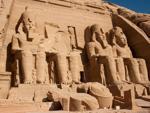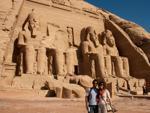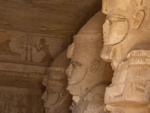On our last day in Luxor we planned to visit Karnak Temple, a complex containing a large group of temples. It is situated two kilometres north of Luxor Temple, and the two temples were originally connected by the “Avenue of Sphinxes”. We arranged a horse and carriage for 6 EGP to Karnak Temple; this was surprisingly cheaper than a taxi. On arrive we organised a one hour tour for 60 EGP, the tour guide shared a few unknown and interesting facts, but a tour guide isn’t necessary.
We entered the temple complex from the west and were presented with a small avenue of ram-headed sphinxes which lead to the first pylon on the inner Temple of Amun-Re. The first pylon is incomplete with temporary mud-bricks still remaining behind, providing an insight into its construction. After the first pylon was the Great Forecourt which housed a large number of open-air artefacts. After the second pylon was the Great Hypostyle Hall, a forest of one-hundred-and-thirty-four columns, initially constructed by Seti I and majority completed by Ramesses II. Between the third and fourth pylon was a large obelisk from time of Thutmose I. In all, there are ten pylons with the last being built by Horemheb.
One of the interesting things within Karnak Temple is the Sacred Lake used by priests to purify them. At the corner of the lake is a sculpture of a scarab beetle which the ancient Egyptians worshipped as a representation of the sun god Ra, due to the similarities between the rolling of the dung and rolling of the sun across the sky.
The rest of the time we enjoyed exploring the temple complex, with its hundreds of artefacts scattered around. There were hardly any other tourists which made for good photographs.
thydzikgooglemap(http://sonyaandtravis.com/maps/egypt-2011-karnak-temple.xml,s)
After visiting Karnak we headed back to the heart of Luxor. Unsure what to do for the rest of the afternoon, we stopped at an outside restaurant that enticed us with 8 EGP bottles of Egyptian ‘Stella’ and which overlooked the Luxor Temple. Cold beers on a hot day, it was a relaxing way to spend the rest of the afternoon that reminded me of Australia.
That evening we caught the sleeper train back to Cairo.






















































































































































